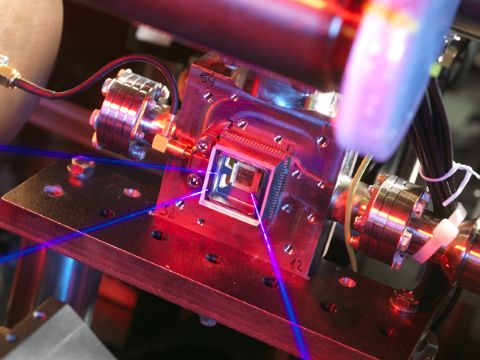May 15, 2025 Research Highlight Physics / Astronomy
Extending the applicability of a key quantum law
Even quantum systems with long-range interactions between particles can be analyzed using a key principle

Figure 1: Ion traps such as the one shown here are one promising technology for developing quantum computers. Trapped ions are also an example of a long-range interacting system that the area law can be applied to. © ANDREW BROOKES, NATIONAL PHYSICAL LABORATORY/SCIENCE PHOTO LIBRARY
By extending a key law in quantum information to systems with long-range interactions, RIKEN physicists have enhanced its usefulness1. This advance could help to design better quantum computers.
Compared with their classical counterparts, systems made up of many quantum particles—such as quantum computers—are horrendously complex to analyze and simulate. This complexity is due in part to the strong correlations between particles, which can act over long distances.
One helpful principle for understanding systems in which the quantum particles are split into two groups is the area law. It states that the amount of information shared between the two parts of a quantum system depends on the boundary between them rather than the total size of the two parts.
“This idea provides profound insights into how information is structured in nature and has far-reaching implications across physics, helping researchers explore phenomena ranging from exotic phases of matter to black holes,” says Donghoon Kim of the RIKEN Center for Quantum Computing (RQC).
The area law simplifies the analysis of large quantum systems because it means it is not necessary to know all the details about the entire system, but just how the two parts are connected across their boundaries.
However, the area law has only been shown to apply to systems that have short-range interactions between their particles. That excludes many systems of great interest.
“In many important physical systems, particles interact with others far away—not just their neighbors,” explains Kim. “These long-range interacting systems are essential for understanding both the large-scale structure of the Universe and the behavior of complex quantum materials.”
Now, Kim, Tomotaka Kuwahara, also of RQC, and Keiji Saito of Kyoto University have shown that the area law at finite temperatures also applies to long-range interacting systems under certain conditions.
“Our result suggests that, by carefully choosing meaningful and realistic assumptions, we can extend the reach of mathematical analysis into areas that were once thought to be out of bounds,” says Kim.
The trio’s achievement has important implications for practical applications of quantum systems such as quantum computers.
“We now have a much clearer understanding of when and how quantum systems can be simulated efficiently at finite temperatures,” says Kim.
“This is especially relevant for quantum computing and quantum simulation, where managing entanglement and thermal correlations is a major challenge.”
The result can help guide the design of algorithms and hardware by identifying the regimes where quantum information remains localized and tractable—even when long-range interactions are present, Kim notes.
Related contents
- Simplifying long-range quantum interactions in many-body systems
- Boson systems break the finite speed limit
- Looking for rules within quantum complexity
Rate this article
Reference
- 1. Kim, D., Kuwahara, T. & Saito, K. Thermal area law in long-range interacting systems. Physical Review Letters 134, 020402 (2025). doi: 10.1103/PhysRevLett.134.020402
